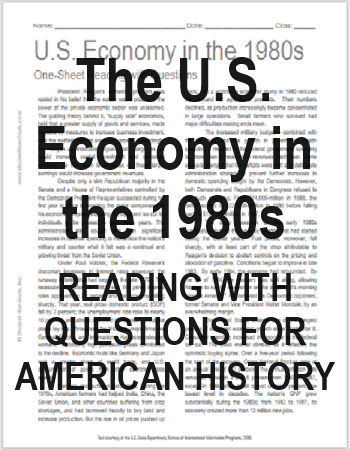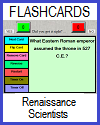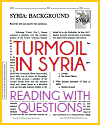| The U.S. Economy in the 1980s Reading with Questions |
|---|
| www.studenthandouts.com ↣ American History ↣ American History Readings with Questions |
|
President Reagan's domestic program was rooted in his belief that the nation would prosper if the power of the private economic sector was unleashed. The guiding theory behind it, "supply side" economics, held that a greater supply of goods and services, made possible by measures to increase business investment, was the swiftest road to economic growth. Accordingly, the Reagan administration argued that a large tax cut would increase capital investment and corporate earnings, so that even lower taxes on these larger earnings would increase government revenues.
Despite only a slim Republican majority in the Senate and a House of Representatives controlled by the Democrats, President Reagan succeeded during his first year in office in enacting the major components of his economic program, including a 25-percent tax cut for individuals to be phased in over three years. The administration also sought and won significant increases in defense spending to modernize the nation's military and counter what it felt was a continual and growing threat from the Soviet Union.  Under Paul Volcker, the Federal Reserve's draconian increases in interest rates squeezed the runaway inflation that had begun in the late 1970s. The recession hit bottom in 1982, with the prime interest rates approaching 20 percent and the economy falling sharply. That year, real gross domestic product (GDP) fell by 2 percent; the unemployment rate rose to nearly 10 percent, and almost one-third of America's industrial plants lay idle. Throughout the Midwest, major firms like General Electric and International Harvester released workers. Stubbornly high petroleum prices contributed to the decline. Economic rivals like Germany and Japan won a greater share of world trade, and U.S. consumption of goods from other countries rose sharply.
Under Paul Volcker, the Federal Reserve's draconian increases in interest rates squeezed the runaway inflation that had begun in the late 1970s. The recession hit bottom in 1982, with the prime interest rates approaching 20 percent and the economy falling sharply. That year, real gross domestic product (GDP) fell by 2 percent; the unemployment rate rose to nearly 10 percent, and almost one-third of America's industrial plants lay idle. Throughout the Midwest, major firms like General Electric and International Harvester released workers. Stubbornly high petroleum prices contributed to the decline. Economic rivals like Germany and Japan won a greater share of world trade, and U.S. consumption of goods from other countries rose sharply.
Farmers also suffered hard times. During the 1970s, American farmers had helped India, China, the Soviet Union, and other countries suffering from crop shortages, and had borrowed heavily to buy land and increase production. But the rise in oil prices pushed up costs, and a worldwide economic slump in 1980 reduced the demand for agricultural products. Their numbers declined, as production increasingly became concentrated in large operations. Small farmers who survived had major difficulties making ends meet. The increased military budget—combined with the tax cuts and the growth in government health spending—resulted in the federal government spending far more than it received in revenues each year. Some analysts charged that the deficits were part of a deliberate administration strategy to prevent further increases in domestic spending sought by the Democrats. However, both Democrats and Republicans in Congress refused to cut such spending. From $74,000-million in 1980, the deficit soared to $221,000-million in 1986 before falling back to $150,000-million in 1987. The deep recession of the early 1980s successfully curbed the runaway inflation that had started during the Carter years. Fuel prices, moreover, fell sharply, with at least part of the drop attributable to Reagan's decision to abolish controls on the pricing and allocation of gasoline. Conditions began to improve in late 1983. By early 1984, the economy had rebounded. By the fall of 1984, the recovery was well along, allowing Reagan to run for re-election on the slogan, "It's morning again in America." He defeated his Democratic opponent, former Senator and Vice President Walter Mondale, by an overwhelming margin. The United States entered one of the longest periods of sustained economic growth since World War II. Consumer spending increased in response to the federal tax cut. The stock market climbed as it reflected the optimistic buying spree. Over a five-year period following the start of the recovery, Gross National Product grew at an annual rate of 4.2 percent. The annual inflation rate remained between 3 and 5 percent from 1983 to 1987, except in 1986 when it fell to just under 2 percent, the lowest level in decades. The nation's GNP grew substantially during the 1980s; from 1982 to 1987, its economy created more than 13 million new jobs. Steadfast in his commitment to lower taxes, Reagan signed the most sweeping federal tax-reform measure in 75 years during his second term. This measure, which had widespread Democratic as well as Republican support, lowered income tax rates, simplified tax brackets, and closed loopholes. However, a significant percentage of this growth was based on deficit spending. Moreover, the national debt, far from being stabilized by strong economic growth, nearly tripled. Much of the growth occurred in skilled service and technical areas. Many poor and middle-class families did less well. The administration, although an advocate of free trade, pressured Japan to agree to a voluntary quota on its automobile exports to the United States. The economy was jolted on October 19, 1987, "Black Monday," when the stock market suffered the greatest one-day crash in its history, 22.6 percent. The causes of the crash included the large U.S. international trade and federal-budget deficits, the high level of corporate and personal debt, and new computerized stock trading techniques that allowed instantaneous selling of stocks and futures. Despite the memories of 1929 it evoked, however, the crash was a transitory event with little impact. In fact, economic growth continued, with the unemployment rate dropping to a 14-year low of 5.2 percent in June 1988. Directions: Read the text above, then answer the questions below. 1. Explain the theory of "supply-side" economics. 2. Describe the recession of 1982. 3. What difficulties did farmers face in the 1980s, and why? 4. How and why did the federal deficit grow in the 1980s? 5. Describe the economic recovery of the late 1980s. 6. What caused "Black Monday" in 1987? 7. Do you agree with Ronald Reagan's economic policies? Why or why not? Give specific examples. Click here to print. Answers will vary. |
 |  |  |  |  |  |
| UNIT I: | Early America | UNIT IX: | Discontent and Reform | ||
| UNIT II: | Colonial Period | UNIT X: | War, Prosperity, and Depression | ||
| UNIT III: | American Revolution | UNIT XI: | New Deal and World War II | ||
| UNIT IV: | New National Government | UNIT XII: | Postwar America | ||
| UNIT V: | Westward Expansion | UNIT XIII: | Decades of Change | ||
| UNIT VI: | Sectional Conflict | UNIT XIV: | New Conservatism | ||
| UNIT VII: | Civil War and Reconstruction | UNIT XV: | Into the Twenty-first Century | ||
| UNIT VIII: | Growth and Transformation | UNIT XVI: | Polarization and Deglobalization |
| www.studenthandouts.com ↣ American History ↣ American History Readings with Questions |








